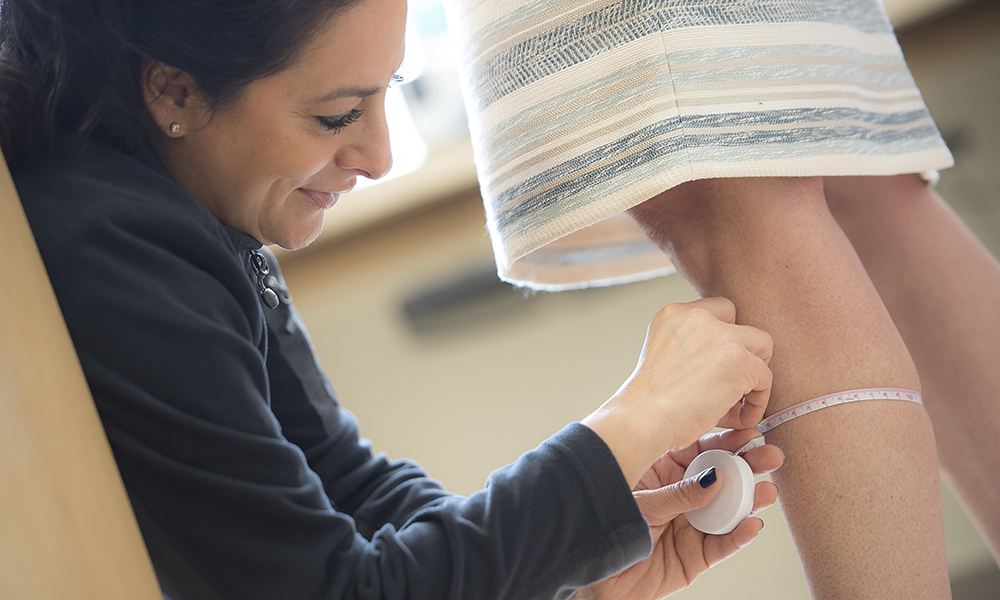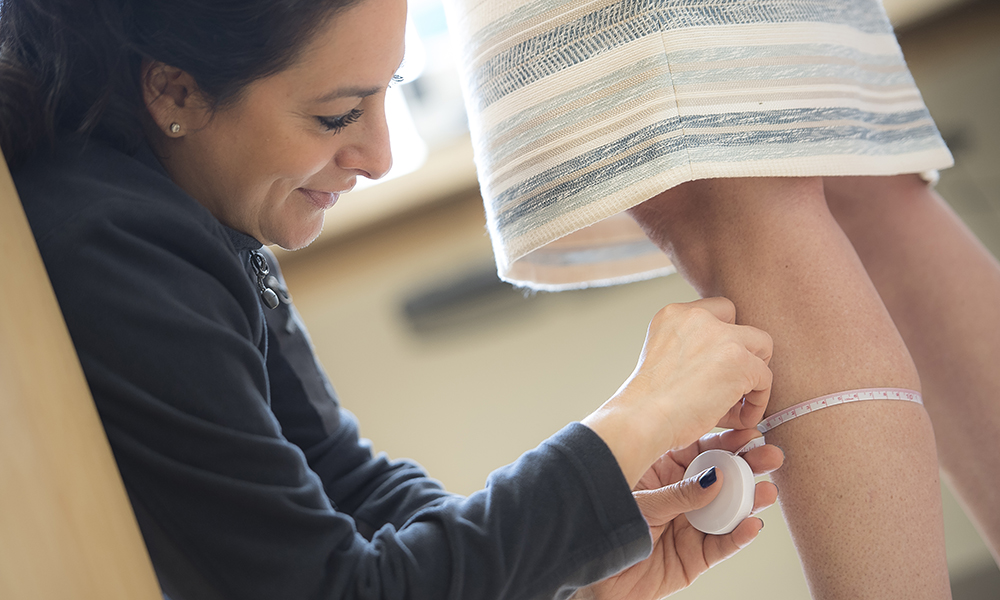Scientists develop and monitor two approaches to fix blood vessel abnormalities that make tumors difficult to treat
Combining the approaches may be a powerful anti-cancer strategy.
Fireman Vascular Center
Contact Information
Danvers
104 Endicott Street, Suite 200
Danvers, MA 01923
Phone: 978-882-6287
Stoneham
21 Montvale Avenue
Stoneham, MA 02180
Phone: 781-438-8117
Waltham
52 Second Avenue
Suite 2100
Waltham, MA 02451
Phone: 781-487-2800
Mass General Vein Care comprises a team of board-certified vascular surgeons, interventional radiologists, vascular medicine specialists and registered nurses who use innovative approaches and the latest technologies to assess, diagnose and treat patients with venous disease.
Our clinicians are available to see patients in Boston, Danvers, Stoneham and Waltham.
We offer many minimally and non-invasive procedures to treat conditions such as:
Our team works together with the patient and referring physicians to coordinate personalized treatment plans for all patients. Our providers are able to diagnose and treat more complex diseases and refer to specialists in the Fireman Vascular Center, when necessary.
For our patients’ convenience and assurance, Mass General Vein Care has an onsite accredited diagnostic vascular imaging located at each of our four clinical sites. We have state-of-the-art ultrasound systems used to perform diagnostic studies as well as mobile ultrasound systems used during treatments.
Our vascular laboratories are staffed with experienced technologists who have extensive training in performing ultrasounds to aid in the diagnosis of venous disease. Our diagnostic vascular services also have the ability to assess pelvic and abdominal veins to aid in the diagnosis of pelvic vein congestion syndrome.
We evaluate each patient's condition and customize a treatment plan that addresses the underlying problem, not just the symptoms. We specialize in the following minimally invasive procedures and therapies:
View our Boston, Danvers, Stoneham and Waltham pages for more information on specific treatments offered at each location.
If you have not previously seen a doctor at Mass General or within the Mass General Brigham please call the Mass General Registration & Referral Center to register at 866-211-6588. Once that is completed, you can contact the office directly to schedule an appointment. If you have any questions they can be addressed at this time.
Some problems with veins are signs or symptoms of a problem called chronic venous insufficiency. These issues are progressive and can be considered more “medically necessary” to treat in order to prevent further progression. These problems are often covered by most insurance companies. There are other vein issues which are smaller and not as likely to cause any serious health issues if they are not treated. These problems are considered only “cosmetic”, and the treatments would not be covered by insurance. Your physician or health care provider will discuss the differences and make sure that you know which procedures are covered, and which are out of pocket expenses.
During the initial consultation, your physician will determine if your treatment needs are medically necessary or cosmetic. Our team will work closely with your insurance plan to provide medical documentation and obtain authorization for any procedures that are deemed medically necessary. Insurance plans vary with regard to their policies on treatments of varicose veins. You will be responsible for any co-payments and/or deductibles required by your insurance company. “Cosmetic” treatments are not covered by insurance, and the cost of the treatment plan will be determined at the time of your initial visit.
The length of the procedures varies based on the type of procedure. Most treatments take less than one hour, but you may be in the office for up to two hours including set up and recovery time. When you meet with your physician, he or she will provide you with this information.
Treatments for leg veins can vary, and can include injection sclerotherapy (which is done without any anesthesia), or other treatments which require some numbing medicine (tumescent local anesthesia). The physicians can discuss and provide additional medication if needed for sedation (anti-anxiety). These can be taken by mouth for some of the more involved procedures, but are not necessary. We do not use any general anesthesia or IV sedation for the office-based procedures.
Risks and benefits of each procedure are discussed fully with the patient while making the treatment plan. For most treatments the risks are rare, minor and self limited. They also vary depending upon the treatment type, vein type, and individual patient. Treatments like sclerotherapy can result in inflammation, and can cause some temporary pigmentation as they heal. Allergic reactions, failure to close veins, temporary injury to the skin or surrounding nerves and the risk of blood clotting are extremely rare. These will be assessed for each patient prior to any treatments. Risks are lower in the office setting, and can be avoided with the use of local anesthesia and careful treatments done by our highly experienced physicians.
Most treatments have very little "down time." We encourage walking and normal activities right away. Most procedures are followed by a 24-48 hour period of some minor itching or tenderness which may be relieved by the application of ice or taking Acetaminophen or Ibuprofen if needed. Most patients are counseled to wear compression stockings or socks for a period of 1-2 weeks (depending upon the treatment performed) during waking hours. Heavy activity, weight lifting, running, etc can be tolerated right away for some, and could be limited for up to 1-2 weeks for other procedures. All instructions are reviewed carefully with each patient prior to any procedures.
Venous disease is a progressive, hereditary condition which can always have recurrences. We will discuss the options with you, and plan the best treatments: with the least risk, the best outcome and lowest risk of recurrence.
For additional information on venous disease, view the Vein Handbook from the American Venous Forum.
Learn more about the services provided by our network of clinics.
With Mass General Brigham, patients gain access to a world-class system of specialized heart and vascular experts.
Mass General is recognized as a top hospital on the U.S. News Best Hospitals Honor Roll for 2025-2026.
Our physicians welcome second opinion appointments to review cases and proposed lines of treatment.
Combining the approaches may be a powerful anti-cancer strategy.
Blood type is not associated with a severe worsening of symptoms in people who have tested positive for COVID-19, researchers from Massachusetts General Hospital (MGH) have reported, dispelling previous reports that suggested a correlation between certain blood type and COVID-19
Call to make an appointment or learn more.

